 | |||
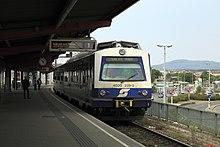 A 4020 EMU at Wien Matzleinsdorfer Platz | |||
| Overview | |||
|---|---|---|---|
| Owner | ÖBB | ||
| Locale | Vienna, Austria | ||
| Transit type | S-Bahn | ||
| Number of lines | 10 | ||
| Number of stations | 181 (52 of them in Vienna) | ||
| Daily ridership | 300,000 | ||
| Headquarters | Vienna | ||
| Website | Vienna S-Bahn | ||
| Operation | |||
| Began operation | 17 January 1962 | ||
| Operator(s) | ÖBB | ||
| Technical | |||
| System length | 650km | ||
| Track gauge | 1,435 mm (4 ft 8 1&fras1;2 in) | ||
| Electrification | 15 kV 16.7 Hz AC Overhead lines | ||
| |||
The Vienna S-Bahn is a suburban commuter rail network in Vienna, Austria. As opposed to the city-run urban metro network, the Vienna U-Bahn, it extends beyond the borders of the city, is operated by the ÖBB (Austrian Federal Railways), and consists of many branch lines. S-Bahn is short for Schnellbahn, which can be translated as "rapid railway".
Network
The Vienna S-Bahn consists of a multitude of branch lines extending beyond the city boundary, most of which converge at a central route segment called the Stammstrecke ("trunk line"). While many of the individual lines run at half-hourly or hourly intervals, they are able to offer combined frequencies of only a few minutes or less along the Stammstrecke. Only line S45 operates entirely within Vienna's boundaries.
Unlike many S-Bahn networks in Germany, the Vienna S-Bahn is not a separate rail network. It is integrated with, and part of, the national railway system. As such, S-Bahn trains share tracks with regional trains (which travel further than the S-Bahn, some regional lines crossing into neighbouring countries) and other rail traffic, including freight trains.
The numbering of the lines has changed since the partial opening of the Wien Hauptbahnhof on 9 December 2012.[1]
| Train services since 13 December 2015 | |||
|---|---|---|---|
| Line | Route and intervals | Lines used | |
| Vienna Meidling – 30′ – Gänserndorf | Stammstrecke – Nordbahn | ||
| S2: Mödling – 30′ – Vienna Rennweg – … S7: Wolfsthal – 60′/120′ – Vienna International Airport – 30′ – Vienna Rennweg – … … – Vienna Floridsdorf – 9′-30′ – Wolkersdorf – ≈60′ – Mistelbach (– Laa an der Thaya) | Südbahn – Stammstrecke – … Pressburgerbahn – Donauländebahn – Aspangbahn – … … – Stammstrecke – Nordbahn – Laaer Ostbahn | ||
| Wiener Neustadt Central – 60′ – Leobersdorf – 30′/60′ – Mödling – 30′ – Vienna Floridsdorf – 30′ – Stockerau – … S3: … – 60′ – Hollabrunn S4: … – ≈60′/120′ – Absdorf-Hippersdorf (– Tullnerfeld) | Südbahn – Stammstrecke – Nordbahn – Nordwestbahn S4: … – Bahnstrecke Absdorf-Hippersdorf–Stockerau (– Franz-Josefs-Bahn – Tullnerfelder Bahn) | ||
| Vienna Franz Joseph – 30′/60′ – Tulln – 60′/120′ – St. Pölten Central | Franz-Josefs-Bahn – Tullnerfelder Bahn | ||
| Vienna Handelskai – 10′/15′ – Vienna Hütteldorf | Donauuferbahn – Vorortelinie | ||
| Vienna West – 30′ – Unterpurkersdorf – 30′/60′ – Tullnerbach-Pressbaum – 60′ – Neulengbach | Westbahn | ||
| Bruck an der Leitha – 30′/60′ – Vienna Central – 60′/120′ – Ebenfurth – 60′/120′ – Wiener Neustadt Central | Ostbahn – Südbahn – Pottendorfer Linie | ||
| Vienna Hirschstetten – 60′ – Vienna Central – 30′/60′ – Vienna Hütteldorf (– 30′/60′ – Unterpurkersdorf) | Marchegger Ostbahn – Laaer Ostbahn – Verbindungsbahn (– Westbahn) | ||
No lines except for S45 always have the same route and final station; most have trains that go further and ones that do not run to the terminal.
History
Planning for the S-Bahn network for Vienna was started in 1954, as a part of reconstruction of the ÖBB. Concrete plans were completed by 1955, but financing was not secured until 1958. The collapse of the investment budget of the ÖBB led to a partial stop of construction in 1960, necessitating a postponing of the grand opening of the network by a little over a year.
The S-Bahn era in Austria began on January 17, 1962. After a day of testing the network with empty trains, passenger transport began at midnight the following day.
From 1962 until 2005, the term S-Bahn was rarely used, the full term Schnellbahn being preferred. Starting with the 2005/2006 timetable, however, S-Bahn has begun to appear in timetables and loudspeaker announcements. Announcements in Badner Bahn trains still use the term Schnellbahn as of 2009.
The Stammstrecke
The Stammstrecke, which translates to "Trunk line", of the Vienna S-Bahn has a length of 13,3 km (8.3 mi) with trains running at headways comparable to those of the Vienna U-Bahn. It is shown on maps (including U-Bahn maps) as a dusty pink line.[2] From the south to the north, the following stations are served:
- Wien Meidling
- Wien Matzleinsdorfer Platz
- Wien Hauptbahnhof (formerly Südtiroler Platz)
- Wien Quartier Belvedere (formerly Wien Südbahnhof tracks 21/22)
- Wien Rennweg
- Wien Mitte (formerly Landstraße)
- Wien Praterstern (formerly Wien Nord)
- Wien Traisengasse
- Wien Handelskai
- Strandbäder (closed 2002)
- Wien Floridsdorf
The Vorortelinie
The most highly frequented single line in Vienna is the S45 Vorortelinie, which translates to "Suburban line". The localities along this line all lie within the city proper, although they had been independent until the late nineteenth century, when they were incorporated, six years before this line opened. Originally part of Otto Wagner's federally operated Stadtbahn, this line was not taken over by the city with the rest of the network in 1925. The line was subsequently closed to passengers in 1932. Although still used for freight traffic for several decades afterwards, the line would not see passenger traffic again until 1987, when it was reopened as part of the S-Bahn after extensive renovation.
Many of the original Otto Wagner stations are still standing and still in use. However, two of the present stations, Breitensee and Oberdöbling were demolished after the original line's closure and rebuilt in a different style by architects Alois Machatschek and Wilfried Schermann. One new station, Krottenbachstraße, was added to the refurbished line, and two of the original line's stations, Baumgarten and Unterdöbling, which had also been demolished, were not replaced. Rebuilding Unterdöbling station is proposed for the near future, as is extending the line south to the Reichsbrücke. The line was extended from Heiligenstadt to Handelskai in 1996, to allow for an easy connection to line U6 of the Vienna U-Bahn.
The Vorortelinie runs at headways of 10 minutes (daytime on weekdays), and is shown on maps (including U-Bahn maps) as a light green line.
Rolling stock
Vienna S-Bahn uses both push-pull cars powered by electric locomotives and electric multiple units.
Current
- ÖBB Class 4020 (since 1979)
- ÖBB commuter double deck cars (de) push-pull bilevel cars hauled by ÖBB Class 1116 or ÖBB Class 1144 electric locomotives (since 1996)
- ÖBB Class 4024 (since 2004)
- ÖBB Class 4744/4746 "cityjet" (since 2015)
Former
- ÖBB Class 4030 (from 1962 until 2004)
- ÖBB Class 5145 (de) (partly as multiple working with Class 4030)
- DB Class 420 (1970 trial)
- SBB-CFF-FFS Re 450 (1992 double-decker train trial)
See also
- Trams in Vienna
- Vienna Metro
- Wiener Lokalbahnen
- Transportation in Vienna
References
- ^ "Netzplan Nahverkehr Großraum Wien 2013" (PDF) (in German). ÖBB. Archived from the original (PDF) on 9 February 2013. Retrieved 1 February 2013.
- ^ https://www.railtech.com/policy/2019/12/27/obb-improves-overnight-s-bahn-service-in-vienna/
External links
 Media related to Vienna S-Bahn at Wikimedia Commons
Media related to Vienna S-Bahn at Wikimedia Commons- Official website

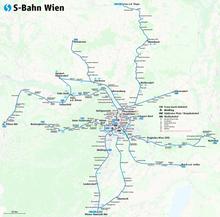
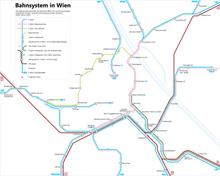


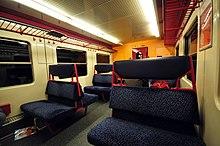

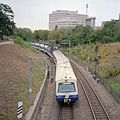
.jpg)



